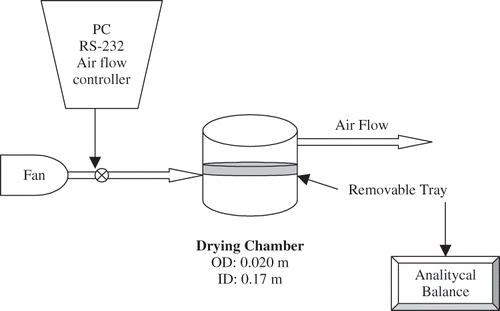Abstract
Moisture diffusivities in high oleic seeds and kernels were obtained from experimental thin layer drying rates in the range of 25–90°C air temperature and 4.2–33.5% initial moisture content (d.b.). Moisture diffusivity back-calculated from Fick´s second law of diffusion varied between 0.85.10-10 and 7.26.10−10 m2/s for seeds and between 0.37.10−10 and 2.39.10−10 m2/s for kernels. The Arrhenius activation energy for seeds and kernels resulted 31 and 24 kJ/mol, respectively. A new model based on the kinetic parameter of Page equation was proposed as a simple tool to predict water diffusion in high oleic sunflower seeds and kernelss.
INTRODUCTION
Sunflower (Helianthus annuus L.) hybrid varieties are almost exclusively used for commercial oilseed production. Native sunflower oil is mainly used for human consumption since it contains a large amount of essential linoleic acid (w6 C18:2) which gives the sunflower seed oil a high nutritional value. In addition, high oleic' varieties have been obtained by chemical mutagenesis of accumulating oleic acid (w9 C18:1) up to 85% in the oil.Citation[1] This oil is nutritionally desired to increase the mono-unsaturated level in the diet. The possibilities of use of this oil are so widespread researchers consider that this differential oil from high oleic sunflower seeds will dominate the type of sunflower to be cultured.Citation[2] This grain is produced at a relative low volume and is still considered a special oilseed. The knowledge of the behavior of these modified grains, especially during post-harvest processing, is not yet available. Drying and storage processes can affect the oil quality of seeds as have been shown previously.Citation[3] The knowledge of drying kinetics contributes to keep the genuine quality of the oil because it is a tool for the proper design and selection of the equipment and operation conditions during post harvest processes. Moreover, diffusivity is a transport property which accurate prediction can lead to optimisation of drying processes, especially in highly automated computer aided systems.Citation[4]
Moisture diffusivity in traditional sunflower kernels and hulls were determined at 40 and 50°C,Citation[5] but no references have been found related to the variation of moisture diffusion with temperature and initial moisture content. Based on the above mentioned situation, the objectives of the present work were: to evaluate the moisture diffusivity of water in high oleic sunflower seeds and kernels; to identify the effect of air temperature; to predict activation energy; and to evaluate a new model to estimate the diffusion of water in seeds and kernels of high oleic sunflower based on the kinetic parameter of Page model.
MATERIALS AND METHODS
The evaluation of moisture diffusivity was carried out based on thin-layer drying experiments, as coefficients determined in this way can be used with confidence for scaling up and optimising industrial driers.Citation[4]
Sample Preparation
Trisum 568 (Mycoyen-Morgan), a striated high oleic genotype of sunflower (Helianthus annuus L.) was selected to carry out this study. Ten bulk samples, each consisting of 5 kg of seed, were prepared from seeds produced at Oriente, Coronel Dorrego, Argentina, after 80 days of physiological maturity stage. The seeds were manually cleaned for foreign matter, broken and immature seeds. The initial moisture content of the seeds was 14.3% dry basis (d.b., g water/g dry solids). Whole kernels and hulls were both obtained by manual dehulling of the seeds. Seeds and kernels were packed separately in double-layered low-density polyethylene bags sealed and stored at low temperature (5°C) in a refrigerator to reduce the rate of microorganisms growing. For each thin-layer drying test, the required amount of material was taken out and allowed to warm up to room temperature for approximately 2 h.Citation[6]
To evaluate the effect of initial moisture content on diffusion coefficient, samples of seeds and kernels at the desired initial moisture content were prepared by adding calculated amounts of distilled water and sealing in separate polyethylene bags. The drying thin-layer kinetics tests were determined at the following initial moisture contents: 4.2, 14.3, 26.4, and 33.5% d.b. for seeds and at 5.0, 13.2, and 23.8% d.b. for kernels. Moisture content was determined by the oven drying method described in ASAE Standard S352.1[7] at 130°C oven temperature during 3 h. All moisture contents were determined using two replications.
Experimental Tests
A laboratory thin-layer dryer () was used to evaluate the drying rates of high oleic sunflower seeds and kernels. A fan drove the air through a heating unit towards the drying chamber in which the seeds were spread on a 0.0232 m2 removable tray. The samples used for the experiments consisted in a single layer of seeds which thickness was less than 0.01 m. The hot air flowed uniformly across the sample at constant velocities in the range of 0.28 to 0.31 m/s, controlled by a damper and measured on a calibrated orifice plate. These air velocities were selected because thin-layer drying of seeds is independent of air velocity when this is higher than 0.2 m/s.Citation[8,Citation9] Before each run, the air was heated at the desired dry bulb temperature through electrical resistances. Relative humidity was measured by using an aspirated psychrometer (Paspst, Type 8550 VW). In order to stabilize the conditions before each test the equipment was previously run for 1 h.
Experimental Design
Drying runs were carried out at five air temperatures (25, 40, 60, 75, and 90°C) and at the initial moisture contents described previously. The moisture loss was registered along time intervals of 2, 4, 6, 10, and 15 min and each test continued during two hours. The equilibrium moisture contents for each temperature and equilibrium relative humidity were obtained from a previous workCitation[10] using the modified GAB model EquationEq. (1) that includes the dependence of the GAB parameters with temperature:
where Xe is the equilibrium moisture content, Ao, A1, BG, and CG are the estimated GAB coefficients for seeds and kernels and ERH is the equilibrium relative humidity of air into the drying chamber. shows the values of Xe used at each experimental condition.
Table 1 Equilibrium moisture content Xe for high oleic sunflower seeds and kernels at the experimental conditions used in the present study
Diffusivity Equations
The equation used to obtain the diffusion coefficient was derived from Fick's second law of diffusion:
where X is the local moisture content (dry basis). This shape of EquationEq. (2) implies the neglecting of shrinkage during drying, an usual assumption for low moisture content seeds. The analytical solution of EquationEq. (2) for the case of sphere, assuming unidimensional moisture movement without volume change, constant diffusivity, uniform initial moisture distribution and negligible external resistances resultsCitation[11]:
where X′ is the average moisture ratio; Xo is the initial moisture content; r is the equivalent radius of the seed or kernel; t is time; and D is the diffusion coefficient. For short times, a diffusional equation based on semi-infinite medium concepts and the expansion of EquationEq. (3) in Mc Laurin series was developedCitation[12]:
where f = 0.661; and av = 3/R for spheres. This approximation is valid for 0.2 < X′< 1 and 0 < z < 1 with z = av√Dt and its accuracy has been tested against experimental data of wheatCitation[13] and quinoa[Citation14]drying. Experimental values of moisture ratio X′ between 0.2 and 1.0 were used to adjust the drying data (X′ versus t) to EquationEq. 4 so as to find the diffusion coefficient at each temperature.The dependence of moisture diffusivity with temperature was verified using the well known Arrhenius-type relationship:
where Do is the Arrhenius factor (m2/s); Ea is the activation energy for moisture diffusion (kJ/kmol); R is the ideal gas constant (kJ/kmol.K); and T is the absolute temperature (K).
A relationship between diffusion coefficient and kinetic parameter k of Page equation was reported for a spherical Al-Ni catalyst.Citation[15] The simplicity of this model will be used to evaluate the moisture diffusion in seeds and kernels of high oleic sunflower taking into account the accuracy of the Page model for the prediction of thin-layer drying rates demonstrated in a previous work.Citation[16] A nonlinear module of Systat Statistical Software Citation[17] was used to calculate the diffusion coefficient from EquationEq. (4). The statistics used to evaluate the goodness of the adjustments were the standard error of the estimated value (SE) calculated as:
where Y and Y′ are the experimental and predicted values of the variable studied; the mean relative percent deviation (P) calculated as:
and the coefficient of determination (R2) at a level of 95% of confidence.
RESULTS AND DISCUSSION
To obtain the values of D valid for the initial drying period of interest, in industrial drying, EquationEq. (4) was fitted to the experimental thin layer drying data, using the equivalent radius of 0.0054 m for seed and 0.0039 m for kernelCitation[18] and assuming that initial moisture content has no effect on moisture diffusivity. These calculated values are shown in , where Ds and Dk indicate the moisture diffusivities in seed and kernel, respectively. The table also shows the corresponding standard errors for moisture diffusivity at each drying air temperature and the coefficients of determination of the fitting of EquationEq. (4) by using the non-linear method. Previously determined diffusivities in sunflower kernels, using EquationEq. (3), were reportedCitation[5] with a value of 0.7 × 10−10 m2/s at 40°C, very close to that reported in this work at the same temperature (0.667 × 10−10 m2/s).
Table 2 Average values (for all runs from different initial moisture contents) of moisture diffusion coefficients in seeds (Ds) and kernels (Dk) at different drying air temperatures, obtained through adjustment of experimental data to EquationEq. (4)
Analysis of variance was used to estimate the significance of the effect of the initial moisture content on the diffusion coefficient. Results of the ANOVA demonstrated that initial moisture content has no significant effect on water diffusion in high oleic sunflower seeds and kernels at a 95% level of confidence, giving values of Snedecor function F of 11.09 and 14.72 for seeds and kernels respectively, against F0.05,3,4 = 9.12.
The Arrhenius type-relationship EquationEq. (5) was proposed to fit the variation with temperature of the experimental values of moisture diffusivity. shows the relationships obtained, where the values of constants and coefficients of determination are presented in . The activation energy (without taking into account the effect of the initial moisture content) in high oleic sunflower seeds resulted 30.7 kJ/mol, 22% higher than in kernel (24.0 kJ/mol). This behavior can be related to previous results[5] that found that moisture diffuses between about two and four times faster through the hull than through the kernel.
Figure 2 Relationship between diffusion coefficient of seed Ds (white symbols) and kernel Dk (black symbols) and absolute temperature.
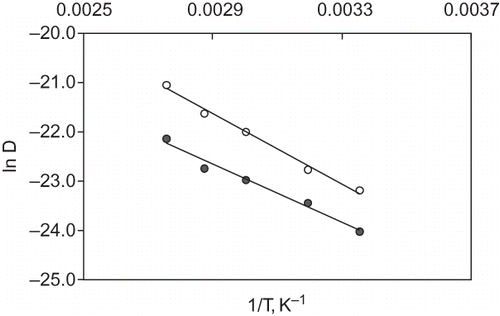
Table 3 Constants and correlation coefficients obtained for the parameters of EquationEq. (5) for whole seed and kernel
A kinetic model based on the Page equation EquationEq. (8), with the parameters k and n temperature-dependent EquationEqs. (9) and Equation(10), was proved previouslyCitation[16] as a good model for thin-layer drying rates for whole sunflower seeds:
where the parameters k and n are temperature dependent according the following relationships:
The values of A, B, E and F and the corresponding statistics are described in . A first analysis between the values of experimental diffusivities in seeds and kernels and the kinetic parameter of Page equation k showed a non linear dependence of expontential form as can be observed from . The results of the best fit analyzed for four air temperatures tested: 25, 40, 75, and 90°C (the remainder temperature 60°C was used to test the adjustment) are summarized in the following expressions:
Table 4 Coefficients of EquationEq. (8) for the temperature dependence of Page parameters k and n for high oleic sunflower seed and kernel
Figure 3 Relationship between moisture diffusivity in seed and kernel obtained from Equationequation 5 and the Page kinetic parameter.
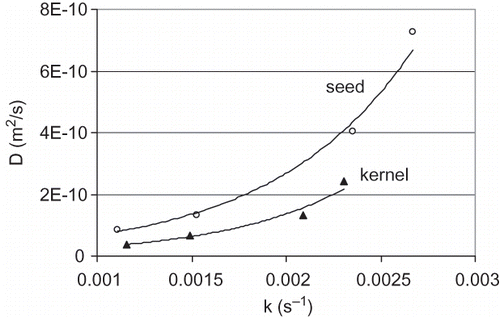
where Dsk and Dkk mean the diffusion coefficient (in m2/s) in seed and in kernel, respectively, as a function of Page parameter k (with k in s−1). The corresponding standard errors of the estimated parameters and the coefficients of determination R2 are tabulated in . Taking into account that the statistics showed a good adjustment, EquationEqs. (11) and Equation(12) was used to evaluated de diffusion coefficient at 60°C to be compared with the experimental value at this temperature. Diffusion of water in seed, Dsk calculated by using EquationEq. (11) resulted 2.5567.10−10 m2/s (absolute error from experimental value resulted 9.1%) and diffusion of water in kernel Dkk obtained from EquationEq. (12) resulted 1.0308.10−10 m2/s (absolute error from experimental value resulted 2.3%). This arrangement shows that EquationEqs. (11) and Equation(12) resulted a good and simple tool to evaluate diffusion of water in high oleic sunflower when kinetic parameter of Page equation is available.
Table 5 Values and statisticals of the coefficients of the EquationEqs. (11) and Equation(12) at 95% level of confidence
If the diffusion coefficients determined with EquationEqs. (11) and Equation(12) are plotted against 1/T, the activation energies can be found in a similar way as previouly, by using the Arrhenius model. The activation energy obtained by applying EquationEq. (5) and using values of Dsk calculated from EquationEq. (11) (with k from EquationEq. (9)), resulted 29.5 kJ/mol (R2 = 0.992), with an absolute error of 3.9% from the activation energy obtained from Ds values obtained from Equationequation 4 (30.7 kJ/mol). In kernel, the activation energy obtained by applying EquationEq. (5) and using values of Dkk from EquationEq. (12) resulted 24.2 kJ/mol (R2 = 0.979), with an absolute error of 0.8% compared with the activation energy obtained from Dk values obtained from EquationEq. (4) (24.0 kJ/mol). These differences can be assumed as negligible and underline the option to use EquationEqs. (11) and Equation(12) to calculate diffusion coefficients.
Drying kinetics curves (X´vs t) with X´ calculated from EquationEq. 4 with diffusion coefficient obtained from EquationEqs. (11) and Equation(12) (for seeds and kernels respectively) were tested against the experimental ones. and show the results obtained for the drying of seeds and kernels, respectively. The goodness of the adjustment was evaluated through the standard error of the estimated value (SE) and the mean relative percent deviation calculated from EquationEqs. (6) and Equation(7), respectively. summarizes the results obtained. The proposed model showed good agreement with respect to the experimental thin-layer drying tests. The mean relative percent deviation resulted lower than 6.322 for seeds and than 8.481 for kernels. The standard error of the estimated value, that is moisture ratio X′, resulted lower than 0.162 for seeds and lower than 0.141 for kernels.
Figure 4 Moisture ratio of high oleic sunflower seeds. Experimental values are represented through symbols while the proposed model based on diffusion coefficient calculated with k parameter of Page model is shown through lines.
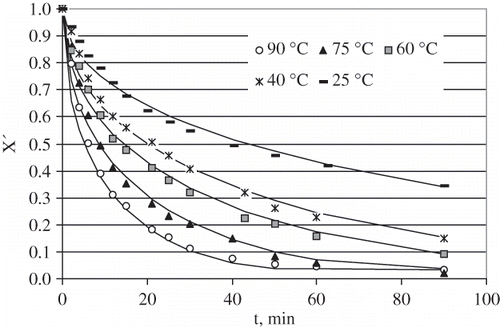
Figure 5 Moisture ratio of high oleic sunflower kernels. Experimental values are represented through symbols while the proposed model based on diffusion coefficient calculated with k parameter of Page model is shown through lines.
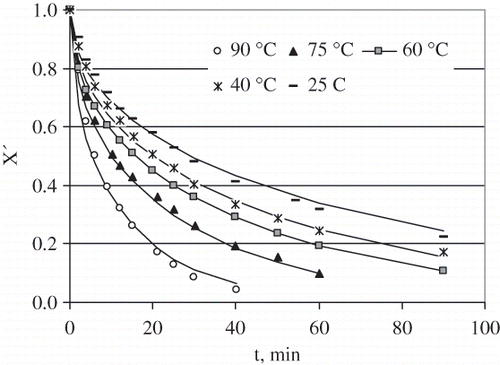
Table 6 Evaluation of the goodness of the adjustment of experimental thin-layer drying test (X´vs t) with EquationEquations 11 and Equation12
CONCLUSIONS
EquationEquation (4), based on the Becker model, showed adequate for the fitting of experimental data of thin layer drying of high oleic sunflower seeds and kernels in the range of temperature from 25 to 90°C and for different water contents. Highly accurate values for diffusion coefficients were obtained using this method. Page model also fitted adequately experimental data for thin layer drying data for whole seeds and kernels. The kinetic parameters k and n could be satisfactorily related to temperature. Based on these previous results, a new model based on the kinetic parameter of Page equation was proposed as a simple tool to predict the diffusion of water in high oleic sunflower seeds and kernels. The goodness of the adjustment evaluated through the mean relative percent deviation and the standard error of the estimated value demonstrated that the proposed model could be used for prediction of diffusion behavior when kinetics drying has previously studied.
NOMENCLATURE
| A, B, E, F | = |
Parameters of the modified Page equation |
| Ao,A1, BG, CG | = |
Coefficients of GAB equation |
| D | = |
Diffusion coefficient, m2/s |
| Dk | = |
Diffusion coefficient in kernel based on Equationequation 5 |
| Dkk | = |
Diffusion coefficient in kernel based on kinetic Page parameter, m2/s |
| Do | = |
Arrhenius factor, m2/s |
| Ds | = |
Diffusion coefficient in seed based on Equationequation 5, m2/s |
| Dsk | = |
Diffusion coefficient in seed based on kinetic Page parameter, m2/s |
| d.b. | = |
Dry basis |
| Ea | = |
Activation energy, kJ/mol |
| k | = |
Page kinetic parameter, s−1 |
| n | = |
Page parameter, dimensionless |
| P | = |
Mean relative percent deviation |
| R | = |
Gas constant, kJ/(mol K) |
| R2 | = |
Coefficient of determination |
| RH | = |
Relative humidity of air,% d.b. |
| r | = |
Equivalent radius, m |
| SE | = |
Standard error of the estimated value |
| T | = |
Temperature, K |
| t | = |
Time, s |
| X | = |
Moisture content, d.b. |
| X′ | = |
Moisture ratio, dimensionless |
| Xe | = |
Equilibrium moisture content, d.b. |
| Xo | = |
Initial moisture content, d.b. |
| Y | = |
Experimental data |
| Y′ | = |
Predicted values of the variable studied |
References
- Garcés , R. , García , J.M. and Mancha , M. 1989 . Lipid characterization in seeds of a high oleic acid sunflower mutant . Phytochemistry , 8 ( 10 ) : 2597 – 2600 .
- Fitch Haumann , B. 1998 . Aceite de girasol modificado. La clave para el futuro [Oil from modified sunflower. The key for future] . Aceites y Grasas , 8 ( 30 ) : 81 – 92 .
- Bax , M.M. , Gely , M.C. and Santalla , E.M. 2004 . Prediction of Crude Sunflower Oil Deterioration after Seed Drying and Storage Processes . Journal of American Oil Chemists´ Society , 81 ( 5 ) : 511 – 515 .
- Zogzas , N.P. , Maroulis , Z.B. and Marinos-Kouris , D. 1994 . Moisture Diffusivity Methods of Experimental Determination. A review . Drying Technology , 12 ( 3 ) : 483 – 515 .
- Rovedo , C. , Aguerre , R. and Suárez , C. 1993 . Moisture diffusivities of sunflower seed components . International Journal of Food Science asnd Technology , 28 : 159 – 168 .
- Joshi , D.C. , Das , S.K. and Mukherjee , R.K. 1993 . Physical properties of pumpkinseeds . Journal of Agricultural Engineering Research , 54 ( 3 ) : 219 – 229 .
- American Society of Agricultural Engineers . 1999 . Standard Engineering Practices Data. American Society of Agricultural Engineers , 46th , 567 ASAE Standards; ASAE .
- Henderson , S.M. and Pabis , S. 1962 . Grain drying theory IV, The effect of airflow rate on the drying index . Journal of Agricultural Engineering Research , : 85 – 89 .
- Hutchinson , D. and Otthen , L. 1983 . Thin-layer air drying of soybeans and white beans . Journal of Food Technology , 18 : 507 – 522 .
- Santalla , E. and Mascheroni , R. 2003 . Equilibrium Moisture Characteristics of High Oleic Sunflower Seeds and Kernels . Drying Technology. , 21 ( 1 ) : 147 – 163 .
- Crank , J. 1975 . The mathematics of Diffusion , 2nd 85 – 86 . Oxford University Press, Inc.: New York;
- Becker , H.A . 1959 . A Study of Diffusion in Solids of Arbitrary Shape, with Application to the Drying of the Wheat Kernel . Journal of Applied Polymer Science , I ( 2 ) : 212 – 226 .
- Giner , S.A. and Mascheroni , R.H. 2002 . Diffusive drying kinetics in wheat. Part II: Applying the simplified analytical solution to experimental data . Journal of Agricultural Engineering Research , 81 ( 1 ) : 85 – 97 .
- Gely , M.A. and Santalla , E.M. 2007 . Moisture diffusivity in quinoa (Chenopodium quinoa Willd.) seeds: Effect of air temperature and initial moisture content of seeds . Journal of Food Engineering , 78 ( 3 ) : 1029 – 1033 .
- Sander , A. , Tomas , S. and Skansi , D. 1998 . The influence of air temperature on effective diffusion coefficient of moisture in the falling rate period . Drying Technology , 16 ( 7 ) : 1487 – 1499 .
- Santalla , E. and Mascheroni , R. July 8–10 2001 . Thin-layer drying models for high oleic sunflower seeds , Edited by: KrzysztofN , Waliszewski . July 8–10 , 307 – 315 . Veracruz, , México : Proceedings of the 2nd Inter-American Drying Conference .
- Wilkinson , L. 1990 . SYSTAT , 323 – 335 . Evanston, IL : The System for Statistics. SYSTAT, Inc .
- Santalla , E. and Mascheroni , R. 2003 . Physical Properties of High Oleic Sunflower Seeds . Food Science & Technology International , 9 ( 6 ) : 435 – 442 .
